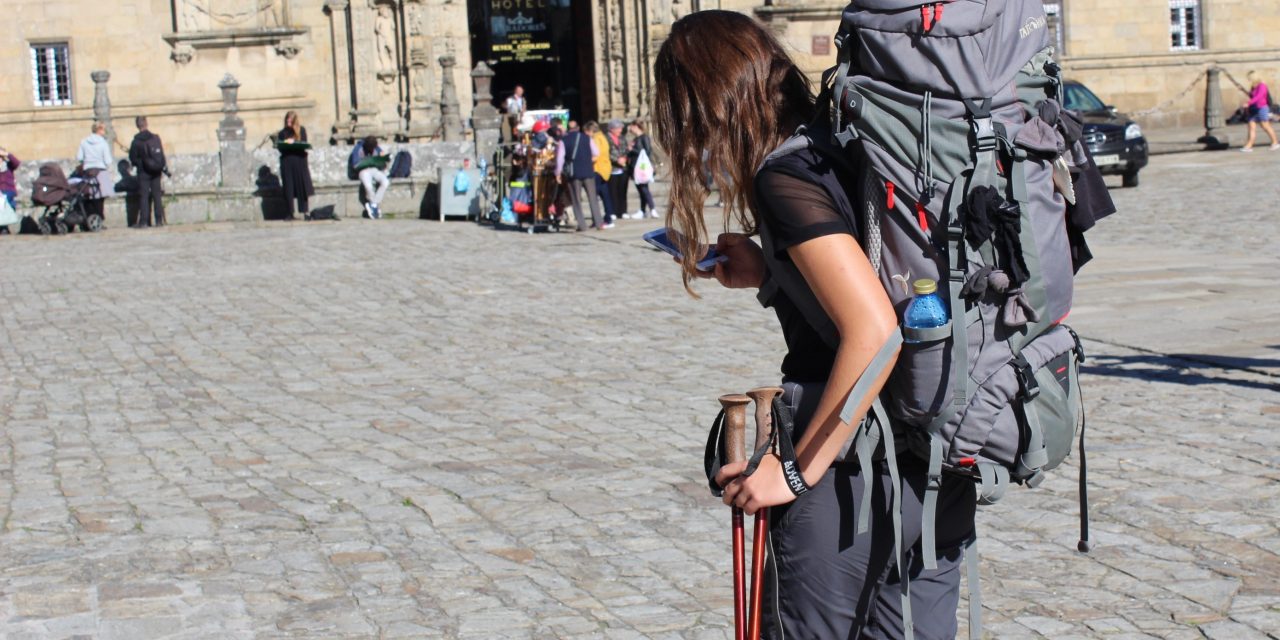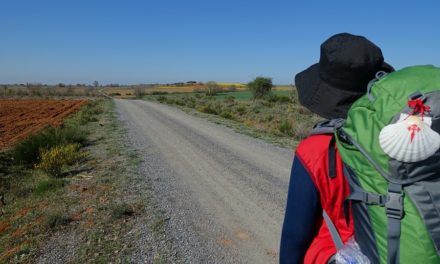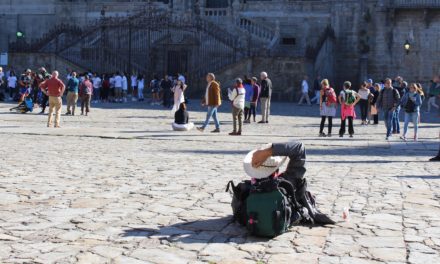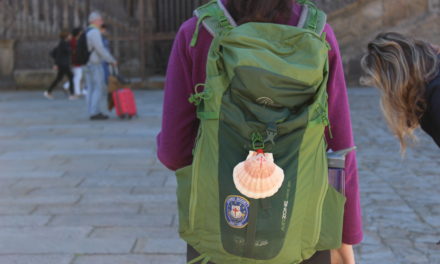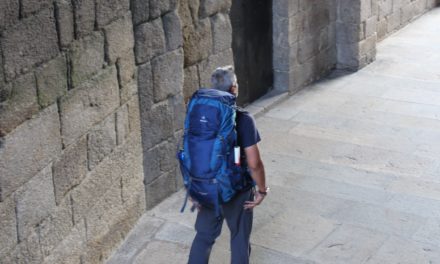In 1981, she and a friend to be came to Spain with a pass to travel Europe by train (Eurailpass). She remembers that they took a train in Vegadeo to go to Ferrol, Coruña and Vigo, but when looking at the map she saw Santiago she suggested to her friend that they get off the train and visit the city. Incredibly it was July 25, the festival of Santiago, so their visit was a very special one. They were most impressed by the botafumeiro, and by the cathedral full of people. Santiago made a lasting impression on them, and although they continued their trip already the theme of Santiago and the Way of pilgrimage was on their minds.
Then her life changed: she met her husband –from Asturian origin-, got married, she started working, she had children … Her husband and she used to walk in the ecological reserve of Buenos Aires every Sunday, but the Camino seemed impossible at that time.
But in 2006 the opportunity arose: they were coming to Spain for a wedding and she suggested to her husband that they take advantage of the trip and try to do at least part of the Camino. They then travelled along several stretches, her husband by bike, she on foot, and they began to see and experience what the pilgrimage to Santiago was like.
After that experience she began to get informed and saw that people from most of the countries were very organized, that they had national associations to inform others about it and help them prepare the Way. She looked for an Argentine association and when they did not find one, they thought that they could form one themselves. And that is what they did : they created it and registered its name.
Finally, in 2008 she was able to undertake her first Way. A friend of hers had had and overcome a tumor and wanted to do to the Camino. She too had overcome one in 2005 and also wanted to give thanks for having overcome it. Thus the two of them came to do the Camino for reasons of faith and gratitude. They started at the beginning of September in Saint-Jean-Pie-de-Port and arrived in Santiago in October.
This was her first Camino and setbacks arose: at Logroño they had to change backpacks and in Cacabelos she suffered a very strong tendinitis. But they did not give up and everything was resolved with just one day of rest.
Since 2008, the Camino de Santiago has become an essential aspect of her life. That experience was recorded. It was an important moment in her life, she had her parents sick and in fact they both died in 2009. But she knew how to face up everything very well, as if they had left her on the Camino de Santiago with a whole network of friends that opened up.
Since then she has returned many times to Santiago and the Camino. She knows the French Way well but also other routes she has travelled: the Camino del Salvador, the Lebaniego, the English Way, the Portuguese Way, The North Way, The Sanabrés Way. And always when she has arrived in Santiago she has felt at home. She is not of Spanish origin but maintains a special contact with Santiago.
Each Way has been different, but in each one she liked the fact of walking and seeing new things and new people. Everyone is the same since there are no social classes on the Camino: everyone sleeps in the same shelter, they all share the same table and eat together … She was delighted by the solidarity of the Camino, how everyone helped each other. First they helped her and then she helped others. That’s why she wanted to be a hospitalera, because what she experienced on the Camino was real solidarity.
This year she has just spent 20 days as a voluntary hospitalera in O Cebreiro. Fray Paco, the popular Franciscan from Santiago, has been in O Cebreiro since last October and she has been able to attend his Masses and see how many people participate in these ceremonies, in their prayers for peace. She believes that what she experienced there is true pilgrimage and true pilgrims, regardless of whether they carry backpacks or not.
From her ways and her work as a hospitalera she remembers many personal stories, stories of self-improvement and faith, of real fighters, like a Canadian woman who walked with an oxygen cylinder in her backpack, or a pilgrim who handed her two ‘credentials’. She told him that with one was enough and he answered that it was because of his son, who was travelling with him through the ‘credential’. She does not know much more than this but it moved her.
After their first pilgrimage in 2009, she and her husband began to work seriously with the Association – which they had only registered – and managed to make it a reality, legally and in practice.
With the association they participated in a pilgrimage to Antarctica of the Hespérides, a Spanish Oceanographic “Buque”, a project promoted in Spain by the Spanish Federation of Associations of Friends of the Camino de Santiago, sealing the credentials of the pilgrims in Buenos Aires. An oceanographic ship of the Spanish Navy included among the distances that appear in Antarctica, the one that separates it from Santiago (17.073km). That ship, which makes the trip every year, stops in her country in Ushuaia and in Buenos Aires. They were with them and some of the crew even decided to do part of the Camino on foot, from Pontevedra. From this project emerged a photographic exhibition that was put on in many cities in Spain and is now in Buenos Aires. They continue to stamp the ship’s credential as it passes through Argentina.
For her it is important to open up to initiatives like this one. She believes that a pilgrim is not only one who travels 800 kilometers. On the Camino she has met people of 80 who walked as far as they could. They covered the distances that could and came to Santiago with pride, satisfaction and strong feelings.
Creating the Friends of the Road Association changed her life. At first they did not think about asking for subsidies or help, they simply offered help to people they in cafes. Later, a delegate from the Xunta de Galicia in Argentina contacted them and offered to collaborate with a Galician centre in Buenos Aires (the “Centro Lalín”) that since then there is a place where they meet every Wednesday. They attend, give information to the pilgrims according to the days they have to go on the Camino and the routes, give credentials to the pilgrims, participate giving talks related to the Camino, either in Spanish centers that call them, festivals such as Buenos Aires Celebrate Galicia, the Night of the Museums, they give advice…
Between the 16th and the 18th of November they have organized the first course in Argentina for Volunteer Hospitaleros in conjunction with the Spanish Federation of Associations of the Camino de Santiago
They also go out for walks in Buenos Aires to prepare physically, and even have a project like in Brazil to create a preparatory Santiago Way in Buenos Aires, a tour of the city, recreating the Camino and passing several churches, starting from the one dedicated to Santiago. They would also like to include other places, such as the city of Mendoza or Santiago del Estero, both under the patronage of Santiago.
They spread the Camino throughout the country, they send credentials to different places in Argentina, but it is true that they do not give credentials to anyone, to do it in a responsible way they ask for a copy of the ticket and the identity document and some information to make sure that people are really going to do the way.
The Camino represents a large part of her life and it will continue to do so. It has changed her life and given her the possibility of creating something and mainly to help all those who want to go on the Camino and don’t have enough information. It also encourages people who want to go, tells them that there are no barriers, that everyone can walk and do it in the most appropriate way to their personal situation.
Now, for example, she will go with a group to Via Francigena, which she last walked in 2015. And then to Rieti to walk on the road to San Francisco as far as Rome or maybe the Via Amerina.

